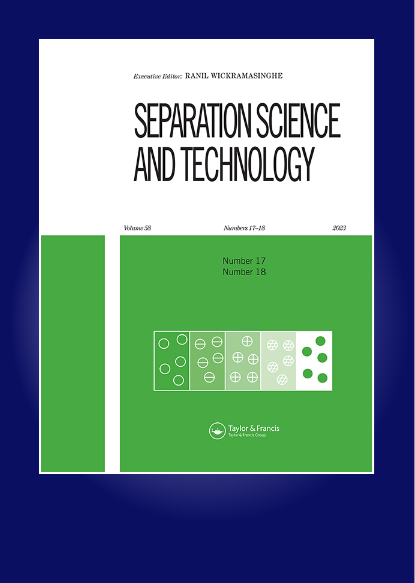Geopolymer-zeolite and geopolymer- iron (III) ion exchanged zeolite pellets as highly regenerable CO2 adsorbents
IF 2.3
4区 工程技术
Q3 CHEMISTRY, MULTIDISCIPLINARY
引用次数: 0
Abstract
ABSTRACT Powdered zeolites have been reported as effective CO2 capture materials. However, pellet form is needed for industrial application. In this study, shaped zeolite X (ZX) and Fe3+ ion-exchanged zeolite X (ZXFe) with geopolymer as binder were produced in forms of cylinder pellets (Ø = 5 mm, h = 5 mm) at low temperature. The geopolymer was obtained through the geopolymerization of metakaolin using NaOH as an alkaline activating agent. The material formed by this way remained the zeolite X structure that was confirmed by X-ray diffraction (XRD) analysis. Additionally, scanning electron microscopy (SEM) results of the two different kind geopolymer – zeolite pellets were considered for observation and comparison. BET analysis was also conducted to determine the specific surface area of the GZX3 samples and GZXFeL3 samples. This kind of analysis also provided the information about the adsorption – desorption curves and pore size distributions of the two pellet samples. The difference of the temperature in the pretreatment process affected the degas ability of the pellet and the series of experiments were carried out to make clear comparison. The highest CO2 adsorption capacities of pellets were found in the GZX3 (containing the zeolite X) and GZXFeL3 (containing the ZXFe). Despite the rapid decrease in the surface areas from 409 to 261 m2/g for GZX3 and GZXFeL3 respectively, GZXFeL3 showed higher CO2 capacities than the other (1.03 compared to 0.96 mmol/g). In the regeneration study, after several cycles of adsorption – desorption of GZXFeL3 pellets, the adsorption capacity of CO2 decreased about 10%. These adsorption and desorption experiments implied that the pellets formed by ZXFe could be a promising adsorbent for the CO2 capture.土工聚合物-沸石和土工聚合物-铁(III)离子交换沸石颗粒作为高度可再生的二氧化碳吸附剂
摘要 据报道,粉末状沸石是一种有效的二氧化碳捕集材料。然而,工业应用需要颗粒形式。在这项研究中,以土工聚合物为粘合剂的定形沸石 X(ZX)和 Fe3+ 离子交换沸石 X(ZXFe)在低温下制成了圆柱形颗粒(Ø = 5 毫米,h = 5 毫米)。土工聚合物是通过使用 NaOH 作为碱性活化剂对偏高岭土进行土工聚合得到的。X 射线衍射(XRD)分析证实,通过这种方法形成的材料仍具有沸石 X 结构。此外,还对两种不同类型的土工聚合物-沸石颗粒进行了扫描电子显微镜(SEM)观察和比较。还进行了 BET 分析,以确定 GZX3 样品和 GZXFeL3 样品的比表面积。这种分析还提供了两种颗粒样品的吸附-解吸曲线和孔径分布信息。预处理过程中温度的不同会影响颗粒的脱气能力,因此进行了一系列的实验来进行明确的比较。GZX3(含沸石 X)和 GZXFeL3(含 ZXFe)颗粒的二氧化碳吸附能力最高。尽管 GZX3 和 GZXFeL3 的比表面积分别从 409 m2/g 快速下降到 261 m2/g,但 GZXFeL3 的二氧化碳吸附容量(1.03 mmol/g 与 0.96 mmol/g 相比)高于其他两种。在再生研究中,GZXFeL3 颗粒经过几个吸附-解吸循环后,二氧化碳的吸附容量下降了约 10%。这些吸附和解吸实验表明,ZXFe 形成的颗粒可能是一种很有前景的二氧化碳捕集吸附剂。
本文章由计算机程序翻译,如有差异,请以英文原文为准。
求助全文
约1分钟内获得全文
求助全文
来源期刊

Separation Science and Technology
工程技术-工程:化工
CiteScore
6.10
自引率
3.60%
发文量
131
审稿时长
5.7 months
期刊介绍:
This international journal deals with fundamental and applied aspects of separation processes related to a number of fields. A wide range of topics are covered in the journal including adsorption, membranes, extraction, distillation, absorption, centrifugation, crystallization, precipitation, reactive separations, hybrid processes, continuous separations, carbon capture, flocculation and magnetic separations. The journal focuses on state of the art preparative separations and theoretical contributions to the field of separation science. Applications include environmental, energy, water, and biotechnology. The journal does not publish analytical separation papers unless they contain new fundamental contributions to the field of separation science.
 求助内容:
求助内容: 应助结果提醒方式:
应助结果提醒方式:


